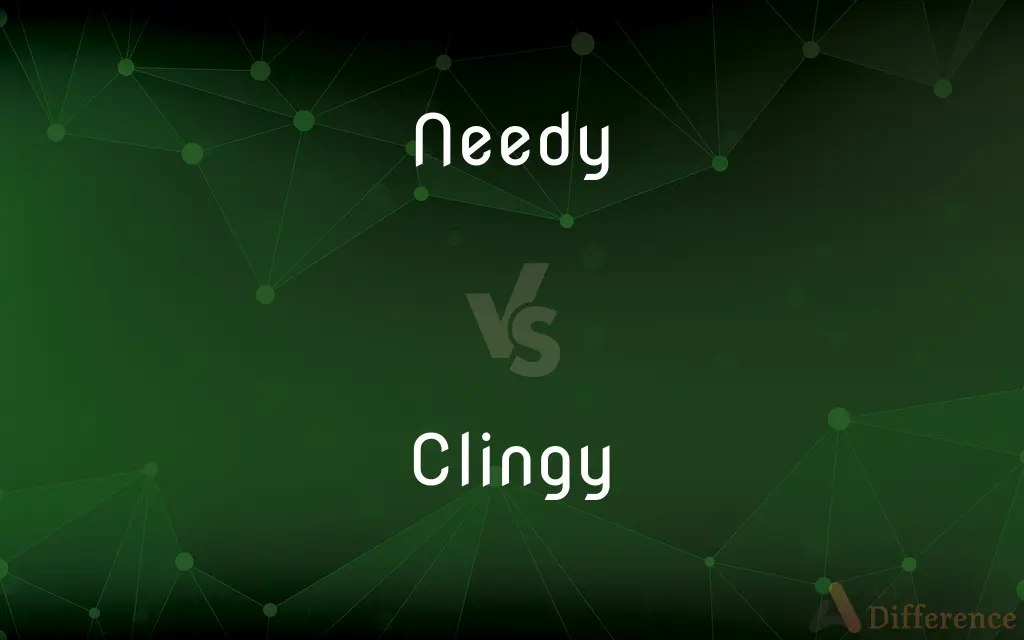Needy vs. Clingy — What's the Difference?
By Maham Liaqat & Fiza Rafique — Updated on April 3, 2024
Needy and clingy individuals both seek attention and reassurance, but needy people primarily require emotional support, whereas clingy people seek constant physical presence or contact.

Difference Between Needy and Clingy
Table of Contents
ADVERTISEMENT
Key Differences
Needy individuals often look for emotional support and validation from others, feeling insecure or insufficient without it. They may express a deep fear of abandonment and a constant need for reassurance in their relationships. On the other hand, clingy individuals desire a lot of physical closeness and time spent with their significant others or friends. They may feel anxious when not in close proximity to those they are attached to, leading them to seek constant contact or communication.
While needy behavior is rooted in the desire for emotional fulfillment and affirmation, clingy behavior emphasizes the physical aspect of relationships. Needy individuals might share their feelings openly, seeking understanding and support, whereas clingy individuals prioritize being together, fearing loneliness or separation.
Another difference lies in the perception of these behaviors by others. Being needy is often viewed in the context of emotional vulnerability and a deep-seated fear of not being valued, which can sometimes elicit sympathy. In contrast, clinginess is frequently seen as overbearing, potentially smothering the personal space and independence of others, which can lead to frustration or irritation.
The impact on relationships also varies. Needy behavior can sometimes foster deeper connections through emotional sharing and vulnerability, encouraging mutual support. Clingy behavior, however, might strain relationships by limiting personal space and independence, potentially leading to resentment or a desire for distance.
Addressing these traits requires different approaches. For needy individuals, building self-esteem and developing a secure sense of self-worth might be key, encouraging independence and self-reliance. For clingy individuals, focusing on building trust in the relationship and fostering individual interests and activities can be beneficial, promoting a healthy balance between togetherness and independence.
ADVERTISEMENT
Comparison Chart
Focus
Emotional support and validation
Physical presence and contact
Behavior
Seeks reassurance and emotional connection
Desires constant proximity and communication
Perception
Seen as emotionally vulnerable
Viewed as overbearing and limiting
Impact on Relationships
Can deepen emotional connections
May strain relationships by reducing personal space
Addressing the Trait
Build self-esteem and independence
Foster trust and encourage individual interests
Compare with Definitions
Needy
Seeking Emotional Support.
John always asks for reassurance in his friendships, showcasing his needy nature.
Clingy
Fear of Separation.
He becomes anxious when his friends plan outings without him, a sign of being clingy.
Needy
Fear of Abandonment.
She expresses a constant fear of being left alone, a sign of being needy.
Clingy
Seeking Physical Closeness.
Anna texts her partner hourly, showing her clingy nature.
Needy
Emotional Vulnerability.
Her openness about her fears shows her needy side, seeking emotional support.
Clingy
Limiting Personal Space.
His expectation to be included in every plan shows a clingy tendency.
Needy
Dependence on Others for Emotional Fulfillment.
Their need for constant approval reveals a deep-seated neediness.
Clingy
Dependence on Presence for Security.
Their unwillingness to spend time apart hints at clinginess.
Needy
Desire for Validation.
He frequently seeks compliments to feel valued, indicating neediness.
Clingy
Desire for Constant Communication.
She calls multiple times a day to check in, reflecting clinginess.
Needy
Being in need; impoverished; a charity that helped needy immigrants.
Clingy
To hold fast or adhere to something, as by grasping, sticking, embracing, or entwining
Clung to the rope to keep from falling.
Fabrics that cling to the body.
Needy
Wanting or needing affection, attention, or reassurance, especially to an excessive degree.
Clingy
To remain close; resist separation
We clung together in the storm.
Needy
In need; poor.
Needy people want to give too, but have few material goods to offer.
Clingy
To remain emotionally attached; hold on
Clinging to outdated customs.
Needy
Desiring constant affirmation; lacking self-confidence.
It's emotionally exhausting to be around her because she's so needy.
Clingy
A clingstone fruit.
Needy
(archaic) Needful; necessary.
Clingy
Having a tendency to cling.
A clingy minidress
Needy
Distressed by want of the means of living; very poor; indigent; necessitous.
Thou shalt open thy hand wide unto thy brother, to thy poor, and to thy needy in thy land.
Spare the blushes of needy merit.
Clingy
Pathetically attached to, or possessive of someone, usually a significant other.
A clingy ex-girlfriend who won't stop calling
Needy
Necessary; requisite.
Corn to make your needy bread.
Clingy
Apt to cling; adhesive.
Needy
Poor enough to need help from others
Common Curiosities
How can one address neediness?
Building self-esteem and fostering a sense of security can help address neediness.
Can needy and clingy traits overlap?
Yes, individuals can exhibit both needy and clingy behaviors, affecting relationships in complex ways.
Can clinginess be a sign of deeper issues?
Yes, it can indicate issues like anxiety, fear of abandonment, or lack of self-esteem.
How do needy people perceive their relationships?
They may view relationships as essential to their emotional well-being and fear losing them.
Do needy individuals recognize their behavior?
Awareness varies; some might recognize their neediness, while others may not see it as problematic.
What drives needy behavior?
Neediness often stems from insecurity and a deep need for emotional validation.
How does clinginess affect relationships?
Clinginess can strain relationships by reducing personal space and fostering resentment.
Is there a cultural aspect to perceiving neediness or clinginess?
Yes, cultural norms can influence how these traits are viewed and expressed.
What helps reduce clinginess in a person?
Encouraging independence and building trust within relationships can reduce clinginess.
Is being needy always negative?
Not necessarily; it can foster deeper emotional connections if managed healthily.
What strategies can help someone become less clingy?
Focusing on personal hobbies, interests, and building a secure relationship foundation.
How can someone support a needy partner?
Through understanding, reassurance, and encouraging their independence and self-confidence.
What is the difference between being needy and emotionally expressive?
Being emotionally expressive involves sharing feelings healthily without an excessive need for validation.
Can clinginess be positive in any context?
In moderation, it can show care and commitment, but excessive clinginess is generally seen as negative.
How does social media influence perceptions of neediness and clinginess?
Social media can exacerbate these perceptions by highlighting constant contact and validation-seeking behaviors.
Share Your Discovery

Previous Comparison
Spicy vs. Chili
Next Comparison
Nausea vs. QueasyAuthor Spotlight
Written by
Maham LiaqatCo-written by
Fiza RafiqueFiza Rafique is a skilled content writer at AskDifference.com, where she meticulously refines and enhances written pieces. Drawing from her vast editorial expertise, Fiza ensures clarity, accuracy, and precision in every article. Passionate about language, she continually seeks to elevate the quality of content for readers worldwide.















































